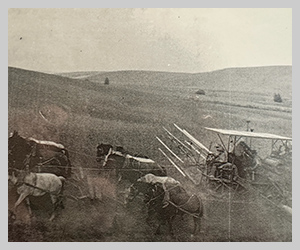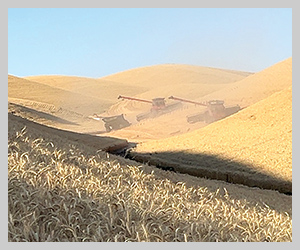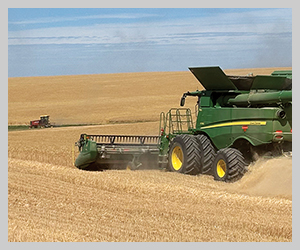
In a recently released report, the Washington State Department of Agriculture (WSDA) is tackling ag viability in the face of a changing climate and figuring out ways to help farmers come out ahead.
Published in March 2025, the “WSDA Climate Resilience Plan for Washington Agriculture” is designed to support the state’s ag viability and vitality through ongoing and future climate change. WSDA worked with stakeholders, including the Washington wheat industry; reviewed science, climate plans, and reports; and assessed the current state of the department’s programs and activities to gather information. The report is intended to guide the “efficient, effective, and equitable distribution of resources to maximize the adaptive capacity of Washington agriculture.”
“I think resilience is really the ability of a farm to withstand a disruption to the system and not just withstand, but really thrive through it,” explained Dani Gelardi, WSDA senior soil scientist and climate coordinator. “The disruptions we’re talking about in this plan are about climate change, whether that be extreme weather, changing temperature patterns, or changing water supply. It’s the ability of a farm to withstand them. It’s really about viability. Can you still turn a profit, support your farm community, pay your workers, and have a sort of meaningful livelihood off of this work?”
The report finds that some of the climate change-related on-farm risks to Washington’s agriculture include:
- Changes to the water supply. Warming temperatures and shifts in precipitation patterns are expected to significantly alter the timing and volume of water available. Water supply is expected to increase early in the growing season and decrease later in the growing season. Changing temperatures may change crop growth patterns, leading to changes in the timing and quantity of water demand.
- Increased threat to water quality. Flooding and heavy rainfall can cause erosion and soil runoff, leading to increased nutrient loads and sediment in waterways.
- Increased impact and losses from extreme events, drought, and fire, which can cause significant losses to crops, livestock, buildings, and equipment. The report finds that insurance programs may need to evolve to protect against damages, but will likely become more expensive, increasing financial stress on producers.
- Risks to crop and forage quality.
- Increased impacts from pests, weeds, and disease. Many pests and weeds benefit from warmer temperatures and increased carbon dioxide. Increased weed pressure may exacerbate the growing problem of herbicide resistance.
- Changing crop suitability. Producers reported a need for information about crops and practices that are resilient to multiple climate stressors, including drought and extreme temperatures.
Off-farm risks include increased threats to transportation and utility infrastructure; increased regulatory costs, risks, and market volatility; and lack of climate data, research, technical support, and equipment.
The plan sets out six goals, complete with strategies and actions, and WSDA’s role in addressing risks and enhancing agricultural resilience. The goals are to:
- Increase agriculture’s preparedness for, response to, and recovery from climate-related extreme events.
- Support the adoption of climate-resilient agricultural practices.
- Safeguard a sufficient quantity of high-quality surface and groundwater for people, farms, and aquatic ecosystems.
- Prepare the agricultural workforce for a changing climate.
- Minimize impacts from pests, weeds, and disease.
- Ensure that laws, policies, and regulations efficiently work towards climate-resilience and agricultural viability.
Gelardi said the department is already incorporating elements of the plan into its programs. For example, WSDA’s nutrient management technical services program is looking at reassessing dairy lagoon storage specifications to accommodate projected climate changes. The Washington Soil Health Initiative is exploring programs that increase soil organic matter so that farms are less susceptible to drought conditions and increased pest pressure. Other goals will require more funding and likely more staff.
“A lot of what we identify (in the plan) is a part of our normal book of work, but, of course, there are other proposed actions that require more funding and focus and more resources, and that is a little bit to be seen,” she said. “We have a state budget deficit. I don’t think we’re proposing anything massively expensive, but we are saying that this needs to be a priority of the state, to support farmers. Let’s put resources towards the things we think are important.”
The report was funded by the Climate Commitment Act, which has generated millions of dollars in revenue for the state, but Gelardi said farmers haven’t seen much of that funding come their way. She hopes the plan is a way to direct more dollars to addressing growers’ climate-related concerns.
“We think that’s a huge opportunity to support the state economy, the state landscapes, farmers, rural livelihoods. There’s a huge opportunity there,’” she explained.
While climate change is usually presented as doom and gloom, the report found a few advantages for Washington growers. For example, the state’s relatively temperate climate, surface water availability, extensive irrigation systems, and variety of crops increase the potential for Washington to become an even more agriculturally important region even as other regions are more severely impacted. Emerging technologies, increased climate investments, and advances in climate science and research funding may help increase farm resilience.
Stakeholder engagement was especially illuminating to the team. They talked to more than 400 farmers and 200 farmworkers. Throughout the document, quotes from stakeholders are used to highlight key points.
“We can look at the data and see the temperature and the precipitation shifts, but when someone says this is how it impacts me and my land and my family, those stories never get old and are really important for people to hear,” Gelardi said. “There were some surprising elements, like hearing that people are as concerned about the impacts of climate change as they are climate-related regulations and market pressures. That’s really important for people to hear because it’s tough to make it in farming, and there are a lot of burdens that people are being faced with.”
While the plan may be aimed more at the institutions that support agriculture, farmers may find it useful as a source to cite when applying for grants and for finding out about WSDA’s existing resources and current projects. For example, if a grower is concerned about changing pest pressures, the plan includes a list of all the resources that are available. (Check out the Goals, Strategies, and Actions portion of the plan.)
“A lot of our programs have been at the intersection of environmental health and farm profitability since the beginning. I think what this does is raise the visibility of our climate work and aggregates our work under a more cohesive narrative and directs future resources,” Gelardi said. “Sometimes, people hear climate change or climate resilience and think it’s some kind of niche environmental concern. And what I really hope the report illustrates is that climate resilience is economic viability and environmental health and worker safety and community livelihoods. It’s so much more than a niche issue, and it touches all of us.”
A copy of the report can be found at agr.wa.gov/washington-agriculture/climate-resilience-plan-for-
washington-agriculture.

















